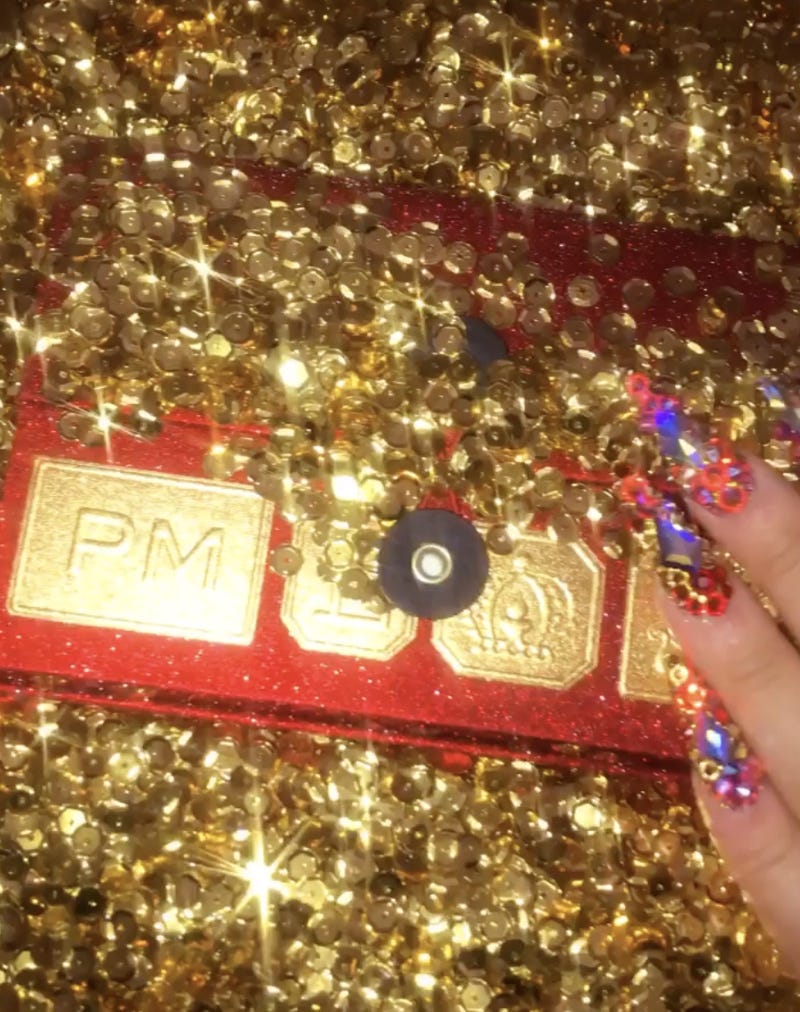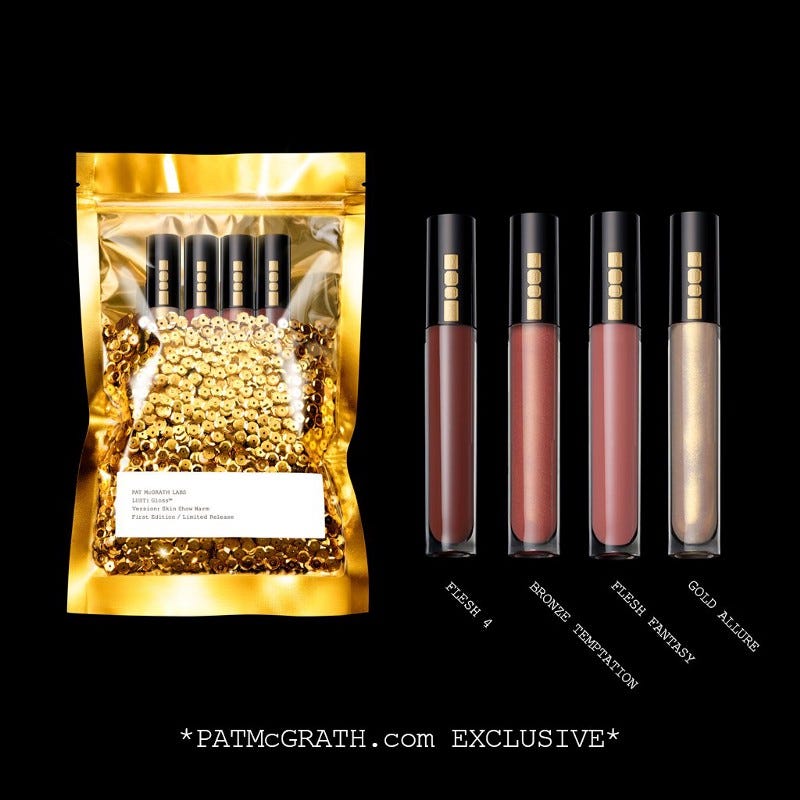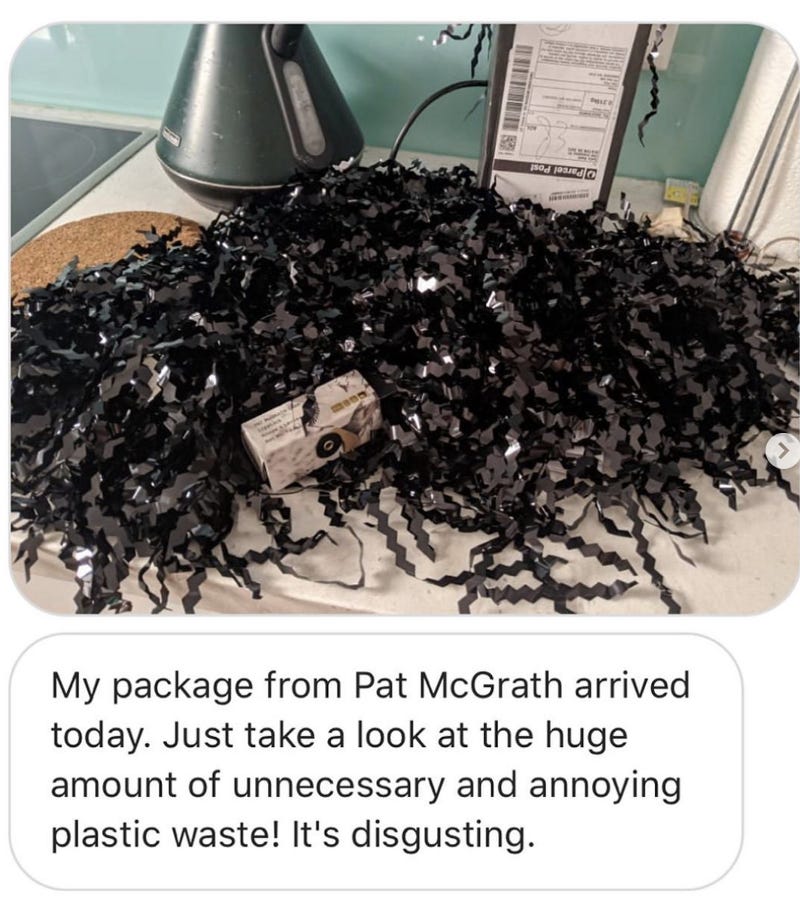Mother Vs. Mother Nature (Or, Pat McGrath’s Glitter & Packaging Problem)
While Greta Thunberg was asking “How dare you?” and Extinction Rebellion was protesting in London and Gucci was pledging carbon neutrality…

@patmcgrathreal
While Greta Thunberg was asking “How dare you?” and Extinction Rebellion was protesting in London and Gucci was pledging carbon neutrality, Pat McGrath was elbow-deep in microplastic particles.
It makes sense. It was Fashion Week, she’s a makeup artist, and those microplastic particles were — or rather are, since microplastic lasts forever — glitter. Thousands upon thousands of trendy flecks of glitter, of all shapes and sizes: Light-catching polyethylene at Tomo Koizumi, from the artists’ own Pat McGrath Labs Mothership VI Palette. Under-eye sequins at Anna Sui. Spangled lips and shimmering shadow at Marc Jacobs. Golden, gem-encrusted accents at Valentino; all of them glimmering on models’ lids and brows and mouths, hypnotizing, as tempting as the Garden of Eden’s sparkliest serpent: “What’s a little microplastic pollution when it’s this pretty?”
Thanks to McGrath — known in the industry as Mother, short for “Mother of Makeup” or “Mother Makeup” — glitter is the year’s biggest beauty trend. (And before you call it “Euphoria makeup,” you should know that McGrath started Euphoria makeup long before the world knew it as Euphoria makeup, as Allure’s Devon Abelman noted in an op-ed.) The MUA went so far as to describe the 60 unique faces she created for the Marc Jacobs Spring 2020 runway, almost all of which featured glitter or loose plastic gems, as “kind of a nod to the real world.” Which is ironic, really.
With McGrath at the helm, the beauty world remains strangely and staunchly detached from the real world. You know, the world that’s up in flames, melting and leaking methane. The one that’s covered in plastic, and (literally) cracking under the pressure.
This isn’t just an opinion. Graph the media coverage of climate change and glitter makeup over the past six months, and you will see one thick, overlapped line, climbing from lower left to upper right. Plot a Venn diagram of the Gen Zs and millennials who cover their eyelids in microplastic glitter particles and those who oppose plastic straws, and you will see, essentially, a circle. (As a reminder, plastic straws are “bad” because they cannot be recycled and, over hundreds of years, they break up into microplastic that infiltrates water, air, soil, animals, and human bodies. Glitter already is microplastic.)
Makeup enthusiasts are merely listening to Mother; following her lead, ignorant to (or maybe just ignoring) the fact that microplastic glitter has a major environmental impact. But in the battle between Mother Makeup and Mother Nature, we’ve picked the wrong Mother — and as a community, beauty has to do better.
True, this is an industry built on excess: the 25-step routines, the three-tier shelfies, the unboxings, sightings of which are enough to trigger a climate change anxiety attack. And true, McGrath is far from the only makeup artist playing with glitter lately. But as the self-embraced Mother of Makeup, shouldn’t she be setting an example?
Does Mother have an ethical obligation to check her influence? To do better for her “children”?
McGrath doesn’t seem to think so. In fact, she’s only leaned harder into her love for all things plastic, shiny, and useless. Watchdog account Estée Laundry recently called attention to the product packaging favored by Pat McGrath Labs, McGrath’s makeup line — packaging so over-the-top that it’s starting to rattle customers (some of whom are actively paying to have microplastic glitter makeup shipped straight to their door, which is saying something).

At Pat McGrath Labs, lipstick tubes — themselves packaging already — are repackaged in plastic pouches, which are then filled with loose plastic sequins. The company appears to ship products purchased directly from its site in boxes over five times the appropriate size, which it then pads with shiny black shreds of plastic. McGrath calls it “opulence,” but what it really is is excessive. It’s wasteful. It’s non-recyclable. It’s contributing more than its fair share to beauty’s biggest problem: packaging.
Every year, the beauty industry creates 77 billion units of plastic packaging. Packaging and packing materials — mailers, pouches, bubble wrap — make up around 40% of global plastic waste, only 2% of which gets recycled. Plastic, at most, can be recycled two or three times before it’s no longer usable. Once it’s no longer usable, it’s destined for a landfill or the ocean. This is where the problem starts.

@esteelaundry
Plastic never dies. Every single piece of plastic ever produced still exists today. The material is not biodegradable, which means it never breaks down; it simply breaks up into microplastic particles. As it breaks up, it leaks pollutants into the soil and water supply. Microplastics are even in the air we breathe.
Currently, there are an estimated 165 million tons of plastic in the ocean, with between eight and 12 million tons entering every year. At this rate, the plastic particles in the ocean will outnumber fish by 2050. That’s not just bad news for fish, it’s bad news for us: Fish ingest microplastics, and humans ingest fish, which is how microplastics enter the human food chain. Microplastics have been found in 114 marine species to date (as well as in tap water samples, so not even vegans and vegetarians are safe). “When researchers from Johns Hopkins looked at the impact of eating seafood contaminated with microplastics, they found the accumulated plastic could damage the immune system and upset a gut’s balance,” reports National Geographic. “In 2017, a study out of King’s College in London hypothesized that, over time, the cumulative effect of ingesting plastic could be toxic.”
These are not obscure statistics; chances are you’ve seen these numbers in articles about plastic waste and sustainability before.
What I want to stress here is this: If you, as a beauty consumer, are upset by the packaging waste produced by McGrath, you should be equally upset by the glitter waste produced by her products.
Again, the problem with plastics is that, over hundreds of years, they break up into microplastic that infiltrates water, air, soil, animals, and human bodies. Glitter already is microplastic, so it has those effects on the environment in real-time.
Microplastics are so detrimental to the health of humans and the planet that the United States fully banned microbeads, a category of microplastics, in 2015 in order “to address concerns about microbeads in the water supply,” according to the Food & Drug Administration. But because of a loophole (the ban only applies to products “intended to be used to exfoliate or cleanse the body”), microplastic makeup remains untouched.
Mother may have you hypnotized with her glitter and her glorious boxes, lulled into a Luxetrance-Stockholm state where you think, “Oh, a little glitter in a big box isn’t a huge deal.” But it is. Scientists are calling for a ban on glitter, as well.
This is not a problem to be pinned on McGrath alone. Beauty brands are guilty across the board, and must do better. But as “Mother Makeup,” and a particularly problematic user of plastic, it is one she needs to address. And if not? Customers may just cut ties with this environmentally toxic parent.
McGrath declined to comment for this story.
If you love the look of glitter but not its microplastic pollution, there are plenty of biodegradable, plant-based options. Explore them here and here.
__
Jessica L. Yarbrough is a beauty journalist whose work has appeared on Vogue, Harper’s Bazaar, New York Magazine’s The Cut, and more. Follow her on Instagram @jessicalyarbrough.



